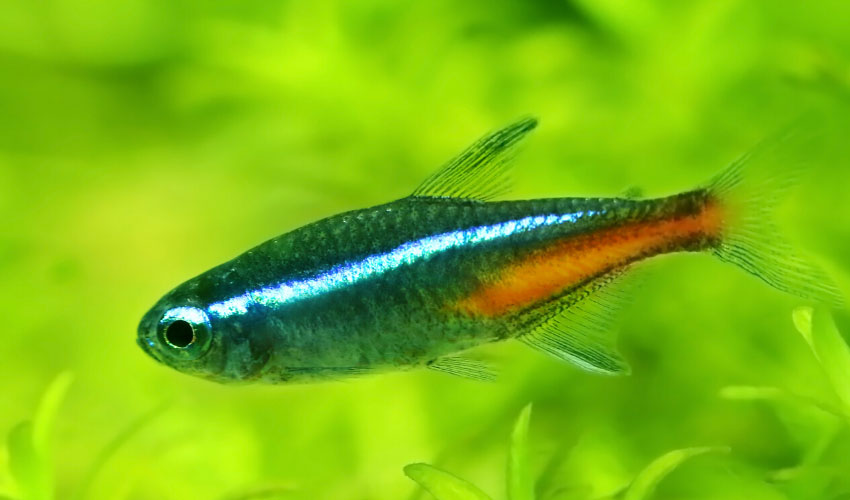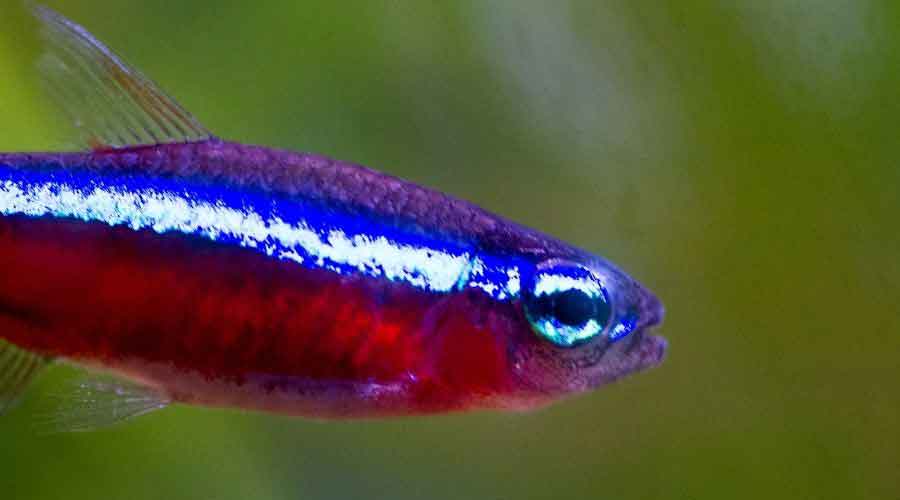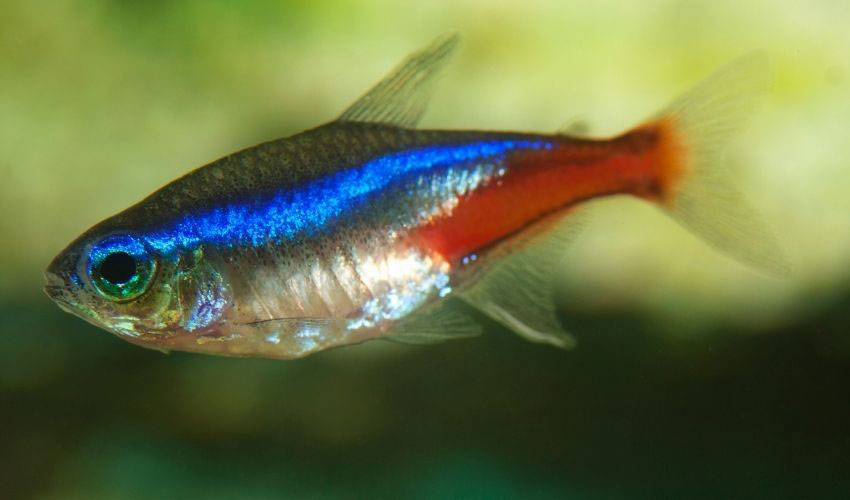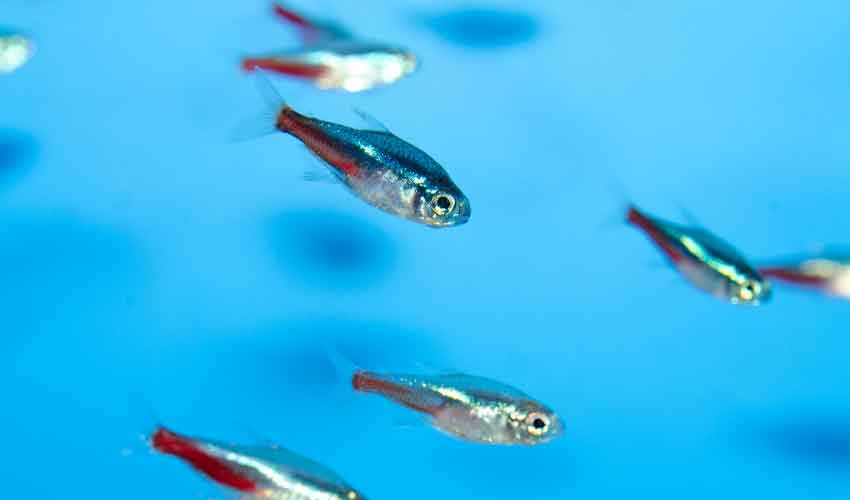In this blog, we will take a look at one of the most popular fish among aquarists, neon tetras. They are a beautiful fish that many people love and a freshwater fish that I personally keep in my own tank. In this article, I’ll discuss many aspects of the neon tetra from the origin, to breeding, to general care.
Table of contents:
- Quick facts
- Origins
- Appearance
- Behavior
- Diet
- Tank Requirements
- Tank Mates
- Lifespan
- Breeding
Neon Tetras: Quick Facts
- Care level: Beginner
- Family: Characidae
- Origin: Africa, Central America, and South America
- Lifespan: 4 to 5 years as a pet
- Size: Approximately 1.5 inches
- Eating Classification: Omnivores
Origins of the Neon Tetra

The stunning Neon Tetra (Paracheirodon innesi) is a beautiful fish for any freshwater aquarium. This fish comes from parts of the world such as Africa, Central America, and South America. Some of these regions are already known for being of the same origins as other beautiful freshwater fish. Today, however, large numbers of tetras kept by aquarists are bred in captivity.
The Tetra’s Appearance
The neon tetra has a sleek body with the female usually having a more rounded belly than the male. These are not big fish by any means, and the average size of neon tetras is right around 1.5 inches. Although, some report them growing to be roughly 2.5 inches long.
When you look at this fish, you will also notice its large bulging eyes. But still, it’s a dazzling fish.
When it comes to the color of tetras, there seems to be a neverending number. They can be found in blue, red, silver, orange, black, white, yellow, and fluorescent colors. Not only do the colors of tetras vary, but so does their overall look.
Below are some of the different types of tetras:
- Neon
- Cardinal
- Black
- Glowlight Tetra
- Emperor
- Black Phantom
- Redeye
- Serpae
- Buenos Aires
- Black Widow
- Congo
- Flame
One crazy thing about this fish is that they can actually turn off their bright hues when they feel threatened. This is a defense mechanism that allows them to hide. This same thing can be done when they are sick or sleeping.
Behavior
My neon tetras have great temperaments, just like they all do. They are the furthest thing from aggressive. Tetras get along with all the fish in my tank and are very energetic fish. They like to swim in the middle of the fish tank with other tetras, but also like to have places to hide.
You’ll also notice that when it’s feeding time, and you drop a few fish flakes into the tank, these guys are always the first ones to show up.
The Neon Tetras Diet and Feeding
Tetras are omnivores. This means they will eat both plants and animals. They do best when fed a variety of food such as fish flakes, brine shrimp, and freeze-dried blood worms. When these fish are younger, you can actually feed them a few times a day, but as they grow into maturity, feeding can be reduced to just one time a day. As a reminder, be careful with overfeeding your fish.
Tank Requirements
The size of a tank required to keep neon tetras always depends on what other aquatic life you plan on keeping. Usually, neon tetras do the best swimming together in schools of six to eight. With this in mind, it’s often recommended that they be placed in a tank that is at least 20 gallons or more. Again, you might want to reassess tank size if you plan on keeping other types of fish or aquatic life in your fish tank. For example, if you were to keep a school of tetras in a fish tank with a blue crayfish as well, you’d definitely want a bigger tank.
Tank Mates
Tetras are great for community fish tanks. Because of their temperaments, they will get along with a vast number of different types of fish. However, it’s always best to do a little research before just placing neon tetras with any type of fish. There’s a huge and rather interesting selection of freshwater fish you can consider keeping in your aquarium.
Below are a few types of fish that will work well with neon tetras:
- Hatchet fish
- Red-tail sharks
- Rainbow sharks
- Rainbow darters
- Danios
- Clown loaches
- Harlequin rasboras
- Guppies
- Clown pleco
- Tiger barbs
The Lifespan of the Neon Tetra
The lifespans of neon tetras can vary based on care and the environment in which they live. Generally speaking, however, the neon tetra, when kept in captivity will live roughly five years. And, in the wild, it will live just around eight years. That’s quite a difference in lifespan from living in the two different environments.
Breeding Neon Tetras
Breeding neon tetras is where it can get pretty tricky. Lots of things have to be done correctly in order for breeding to be a success.
To breed neon tetras, you will need a separate fish tank. The first thing you’ll want to do is to get the water conditions just right. The water should have a hardness of 1 to 2 dGH, and a pH of 5.0 to 6.0. It should also be kept between 72 to 75 degrees.
It’s suggested to use a sponge filter for filtration. Also, it’s a good idea to place live plants into the breeding tank.
Always remember to cover the tank because it’s common for spawning fish to jump. You’ll also need to cover the sides of the tank to reduce light.
You’ll want to feed the neon tetras that will mate live food before placing them into the breeding tank. It’s important that when you place the fish into the tank, there is no light.
On the next day, slowly introduce light into the tank. Do not do this too quickly. As this happens, the male and female will come together during spawning and the female will release over 100 eggs into the water. The eggs will often stick to plants in the tank. This is normal.
It’s important to remove both the male and female fish from the tank immediately after the eggs are laid. If not, the male and female will eat the eggs.
After the male and female are removed from the tank, keep the eggs under very low light and allow 24 hours or so for hatching. After feeding off of their eggs for several days, the tiny neon tetras will be able to swim on their own. Once this happens, they will need to be fed tiny amounts of food that include rotifers, egg yolk, or store-bought fry food. After the first month, these new fish will develop their adult tetra colors.
It’s important to note, that of the hundred-plus eggs that are laid, the majority will not survive.

Recap
In this blog, we looked at a popular type of freshwater fish, the neon tetra, and the different types of tetras overall. This is a fish that is easy to care for, lives for about five years in captivity, and has a great temperament. Therefore it is a great fish for community tanks. These fish do best when swimming in small schools, and if you plan on keeping them in groups of six to eight, you will want at least a 20-gallon tank. If you decide you want to add even more fish to your fish tank, you should consider an even larger tank size. Neon tetras are omnivores and can and should be fed a wide variety of food including brine shrimp, freeze-dried blood worms, and fish flakes. Finally, we talked about breeding and how it can be tricky, but if done right, you can hatch quite a few neon tetras.
Do you keep neon tetras in your fish tank?


